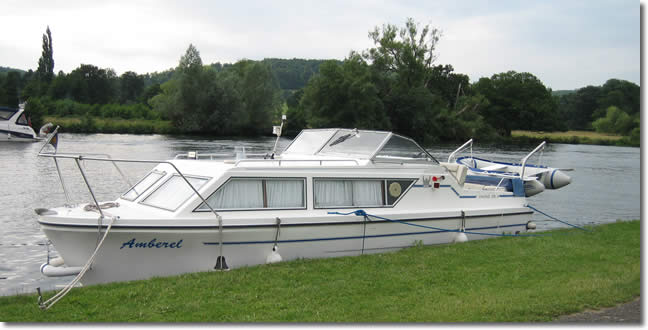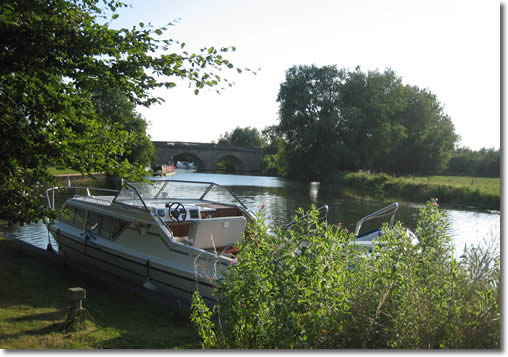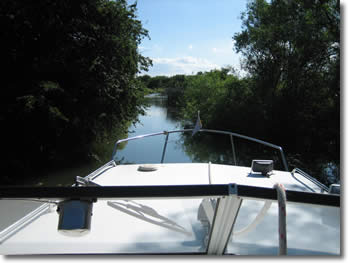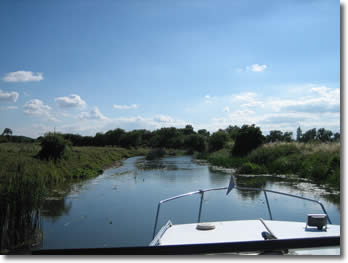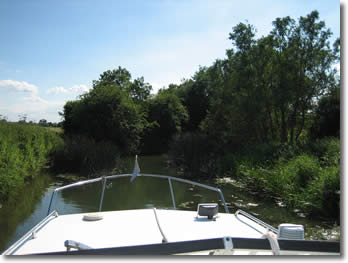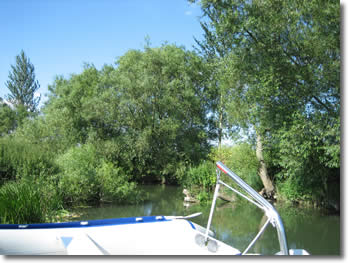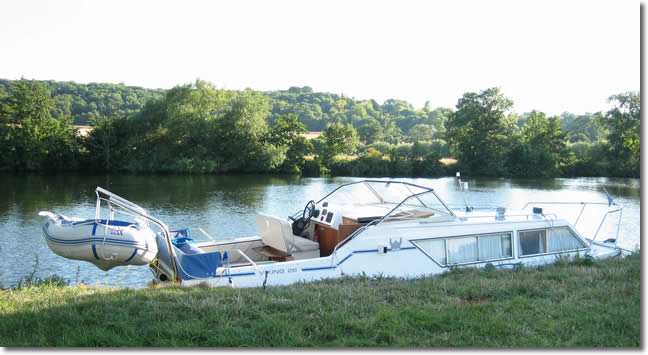|
you have Guest user access (not logged in)
|
||
      visitors since May 2003 ClubSite © ver 1.3 |

|
|
click here to return to the gallery list
|
Cruising
the upper River Thames
- by Andy Lawrie
|
A quick trip from Chertsey to the Head of Navigation at Lechlade and back, in "Amberel", a Viking 26 wide beam cruiser.
The weather forecast was good and I had a week long hole in my work schedule, so it was a good time to go. The only downside was that the rest of the family had commitments they couldn't rearrange, so it was a case of going by myself. I took the inflatable dinghy "Hoppy" with the intention of seeing how far I could go past Lechlade - there is a right of navigation to Cricklade but the river is not maintained beyond Inglesham.
Friday.
Chertsey to Henley, a very familiar journey. Henley Music Festival this weekend, The lock keeper at Hurley thought it would be difficult to find a place to moor, but there was loads of room at the Remenham end of the reach and the first 'photo shows "Amberel" moored there.
Saturday.
The main Henley Regatta is long finished, but another one for "senior" competitors was taking place with a great deal less pomp.
Stopped at Caversham to watch the Silverstone qualifying and to do some shopping at Tesco.
On to Benson, where I met VOC member Phil Ray, who is berthed in the marina there. Phil's neighbour was away and I was able to tie up next to Phil's boat, "Benson Lady". Went for a meal with Phil in the Three Horseshoes. Phil keeps "Benson Lady" up-river because he prefers the quieter and more rural aspect, but by coincidence he lives in Chertsey, not far from where I moor "Amberel".
Phil is also going up to Lechlade, but at a more leisurely pace and with the intention of being there for the Fairford Air Display.
Sunday.
Stopped at Abingdon to watch the British F1 GP.
As this was my first trip to Oxford in this boat, I was unsure whether I would get under Osney Bridge without dropping the screen. I prefer to avoid this as it is a real hassle, but it went under with 6 inches to spare. In the event it was another bridge further upstream (I think it was Godstow Bridge) that proved the tighter fit, as while it is higher in the middle it has a less flat arch than Osney and the sides of the screen cleared by only 3 or 4 inches.
At Eynsham the keeper kindly let me moor on the lock island as the 24 hour mooring was wholly occupied by a long narrowboat. The second 'photo is taken from the lock island and shows Swinford toll bridge. Rang some old friends who live about a mile from Eynsham lock, only to find they were at John O'Groats in their caravan.
Monday.
A small problem at Northmoor Lock - there are tall wooden posts at the side of the lock and an iron band on one was nearly half an inch proud of the wood. This caught the starboard gunwhale, the keeper and I only spotting the boat was tilting to one side moments before it slipped out, taking a small gouge out of the gel coat. The keeper was very apologetic and recorded the incident.
On to Lechlade, to the Round House at Inglesham and beyond.
The river became narrower, as expected, but first mile was very open, with plenty of water. The number of rushes and trees increased, making navigation increasingly difficult, but the weeds were not an insuperable problem and there was still plenty of water - the whole time I never registered less than 5 feet even at the edges, where I spent a fair bit of time dodging around the trees. After about 3 miles the route was blocked by a fallen tree. Fortunately I was able to wind in a small pool below the obstruction. The banks were high and completely overgrown, and as I couldn't tie up I dropped an anchor at each end of the boat. I dropped the dinghy off the davits and went on a short exploratory trip, then tied it to the side of "Amberel" ready for my "assault" upstream the next morning.
Several photos of the river above Lechlade, the obstruction that finally stopped me, and the small pool in which I moored for the night.
Tuesday.
Made myself sandwiches and thoroughly prepared for what might possibly have been a long trip in the dinghy, up to about 10 hours. The dinghy has an electric motor, and I put 2 x 100AH gel batteries in for this trip. I do have a petrol outboard for it, but that vibrates and is unpleasantly noisy, and I felt the electric drive was far more suited to this purpose. I set off.
The first problem was some swans - on a river where the channel was rather less than 10 feet wide it wasn't easy to convince an aggressive team leader that you were trying to go round them and not at them. But very soon the problems became more severe. Weeds. They very quickly got thicker and thicker, and they stalled the electric motor. Clearing the prop only got me another few feet, and as there was a considerable current I could lose as much ground each time as I had made while it was running. I unshipped the oars and tried to row, but the weeds were now so dense I could barely dip them below the surface of the water. There was no point in persevering, so I turned around and let the current carry me back past the swans and to "Amberel" a mere hour after I had left. I was disappointed - having got so much further in "Amberel" than I had expected I had hoped for similar success in "Hoppy", and a meagre mile or so was right at the lower end of my expectations.
Hauled "Hoppy" back onto the davits, dropped the canopy and headed back into Lechlade. Moored up in the town and gave "Amberel" a good mop down to get rid of the insect life and foliage she had picked up the night before. Into town for some provisions and then back down the river.
At Radcot Lock met Terry and Pearl, friends of mine from Sunbury Computer Club who this year have moved their boat "Dulcinea" to the Thames and Kennet Marina. Terry and I often don't know when and where the other plans to go, but we nearly always bump into each other.
Had a text message from Phil to say he planned to be at Newbridge that evening, so I stopped there instead of going back to Eynsham as originally intended. We went to The Rose Revived for a drink and a meal.
Wednesday.
Bought some honey for my wife from the Northmoor lockkeeper.
Reached Pinkhill Lock to be informed a Drought Order had been imposed and, with the intention of saving water by reducing lock cycles, was requested to wait for 15 minutes to see if another boat appeared. None did, so they locked me through by myself anyway. This was going to be a recurring theme throughout most of the rest of the trip. Sometimes I arrived at a lock and made up a "lockful", and therefore was not delayed, other times I had to wait a variable amount of time. While single handing the boat over a distance this is not too much of an imposition; it gives you a few minutes to visit the loo, make a cup of coffee, clean the boat down, etc.
At Godstow the keeper was filling half a dozen watering cans for the flowers. I jokingly asked him if they had also been stopped from pumping water out of the lock as is customary for this purpose, and it turned out to be the case.
From Pinkhill Lock you can't see the weir, but at those locks where the weir is visible, which is more than half of them, there appeared to be a considerable volume of water passing over, certainly enough to fill the lock in a minute or two. I wondered if there was some reason that a certain volume of water had to pass over the weir instead of through the lock and asked a few of the keepers about it. I received different answers, but none made any sense. Several other people I spoke to had a similar experience. One keeper said they had to keep a level of water in the pound below, which ignored the fact that cycling the lock would have the same effect. Another said that there wasn't much water going over the weir, when a glance at a long line of turbulent white water was enough to see this demonstrably was not true. I didn't argue with the keepers because I could foresee no possibility that doing so would result in my enlightenment, but the lack of a logical explanation left me with the feeling that it was done simply so they could be seen to be doing something, whether that something had any real benefit or not.
When I got back I looked at the EA web site. This referred to their Drought Plan, which said "Action will be taken within regulatory constraints to maximise the number of vessels being passed in any one lock passage", but it also said that ash bags and plastic sheets would be used to staunch leaks through the weir structure. I don't know if leaks through the weir structure were being staunched or not, but all these actions are irrelevant to saving water while the weirs are set to allow it to flow straight over the top.
The Drought Plan says "Disappointment, anger and hostility from customers can often arise because we fail to be open and honest about our limitations, methods and processes. Inadequate communication will often lead people to jump to their own conclusions …". I'm more than willing to do my bit to mitigate the effects of the drought, and "disappointment, anger and hostility" are far too extreme to describe my reaction. But I'm not stupid and a silly or illogical answer is even worse than none at all. I certainly feel their communications were inadequate - if there is a good reason they singularly failed to explain it.
Moored at Shillingford for the night.
Thursday
Shillingford to Medmenham, stopping again at Tesco in Caversham for supplies.
Noticed John Whitmore's boat "Arivat" was back at its moorings in Henley, it was away on my trip up.
Moored at Westfield Farm, final photo.
Friday
Medmenham to Runnymede. Held up at Bray for and hour and a half due to a combination of the Drought Order, a couple of large passenger trip boats, dozens of old boats making their way upstream to Henley classic boat rally slowing down the lock cycling, and the fact that it's probably the smallest lock on the lower Thames.
There was plenty of time to get back to Chertsey this evening, but it was such a pleasant afternoon that I rang my wife and asked if she minded if I stayed out another night. I moored at Runnymede next to a small narrowboat owner from Staines who was stopping near home for the same reason as me, and then we were joined by the same cruiser I had moored next to in Shillingford 2 nights before.
Saturday
All three boats moored together left together at 08:30 and entered Bell Weir Lock before the keeper arrived. By 10:30 I was back in my berth at W.Bates. (Many
thanks to Andy for his kind permssion to include his © photos and
text on this site) |
